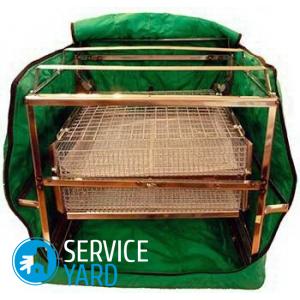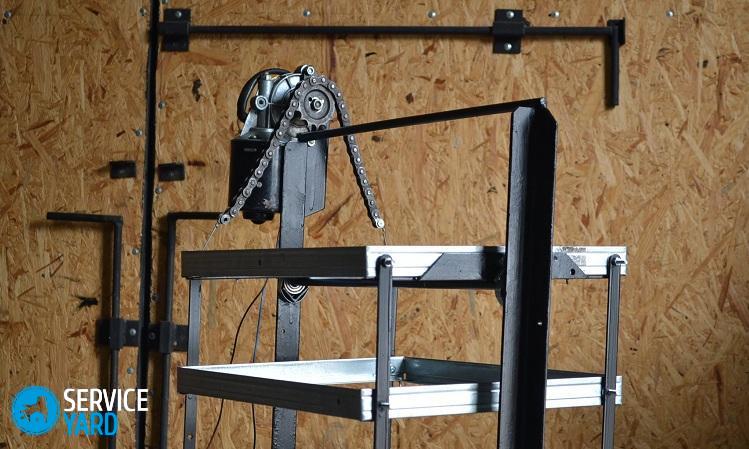DIY incubator trays

Many farmers are experimenting with self-made incubators. The Internet is literally full of drawings and descriptions - from simple techniques to high-tech schemes. Today, the topic will be somewhat highly specialized, concerning only one component of the incubator - the egg tray. Do-it-yourself incubator trays can be made in different ways, each of which has its own advantages and disadvantages. Consider the most common and effective methods.
to contents ↑Why flip eggs in an incubator?
Older people probably remember the good and clever children's story of N. Nosov about a family of chickens. So, observant young naturalists, having built an incubator with their own hands, tried to solve the problem of how exactly and how often eggs should be turned over (similar to how a brood hen does).
Why turn over material placed in an incubator? There are several reasons for this:
- When turning, the nuclei are uniformly heated, since the heat source in the device is fixed motionless on one side only.
- Uniform flow of fresh air around eggs. This problem is relevant in the incubation of chicks, and when using a brood hen.
- Periodic flipping prevents the embryo from adhering to the shell membrane. If you neglect this, the percentage of hatching of the chicks is significantly reduced, as the embryos die.
Important! Most experts recommend turning the hatching eggs to the complete formation and closure of the germinal membrane (allantois).
You can track the process of formation and closure of the germinal membrane using an ovoscope. The complete closure of allantois is indicated by an increase in the air chamber at the blunt end. From the sharp end, the eggs become dark.
to contents ↑The choice of the mechanism of revolution of eggs in an incubator:
- The minimum flipping frequency is twice a day.
- For horizontal laying of the incubation material, a half-turn is made.
- Some farmers practice turns up to 6 times a day.
Turning the eggs by hand is very difficult, especially if there are a lot of them. It is much more convenient to use a mechanical or automated reverser.
There are 2 types of mechanical reversers:
- Framework.
- Inclined.
Let's consider both mechanisms in more detail.
Framework
The principle of operation of the frame mechanism is based on the rolling of eggs by the frame, they scroll around the axis.
Important! Such a mechanism is effective only for horizontal laying of incubation material. The frame can simply move or rotate around an axis.
Pluses of frame rotation:
- Low power consumption. In the event of a power outage, a backup power source can be used.
- Functionality, ease of maintenance of the mechanism.
- Compactness, small size.
Cons of the frame mechanism:
- For efficient operation of the mechanism, the shell must be perfectly clean. Even slight contamination degrades turning efficiency.
- The connection between flipping efficiency and egg size - this problem is completely eliminated in the device with the rotation of the frames.
- Risk of damage to eggs when turning - this applies to improperly adjusted equipment.
Inclined
The tilt mechanism works on the principle of a swing. It is used for top loading technology.
Benefits:
- Guaranteed egg rotation by a given degree, regardless of diameter. This is a versatile technique that is suitable for all types of poultry.
- Safety, the risk of damage to the hatching material is small, since the range of movement of the eggs is small, the eggs do not hurt each other so much.
Minuses:
- The complexity of the service.
- Relatively high cost.
- The technique is large.
to contents ↑Important! The choice of a specific incubator model, in addition to the flipping mechanism, also depends on many other factors: energy consumption, size, tray capacity, cost of the device, as well as individual preferences of the poultry farmer.
Hatching tray specifics
The frame mechanism of the coup is quite convenient and at the same time inexpensive. When choosing trays with a frame mechanism, the following should be considered:
- Loading volume. This is the most important indicator. You need to choose one or another characteristic based on the number of houses. If you are not going to increase the population, then it makes no sense to buy equipment with a significant margin.
- The cheapest models are made in the form of thin frames. At the same time, their reliability is minimal. The frames are easily bent, which may cause the mechanism to fail.
Important! The best option is models in which the cells are completely isolated and the sides are high.
- The cell size should correspond to the diameter of the egg. For example, quail eggs should not be placed in a cell for turkey eggs. The effectiveness of the mechanism depends on this.
to contents ↑Important! If you want to purchase a universal device that is suitable for different types of eggs, then your option is a device with removable partitions in trays. In such an incubator, eggs of different sizes can be laid simultaneously.
DIY incubator tray with swivel frame
For the independent manufacture of an automated rotary mechanism, it will be necessary to extract knowledge of mechanics and electrical engineering from the back of the memory. The choice of electric motors is quite large, so it’s easy to select materials. It is important to observe the following principles:
- Conversion of the circular motion of the rotor part of the electric motor in the reciprocating movement of the frame in the horizontal plane. This can be achieved by the connecting rod mechanism, when the rod, fixed at one of the points of the circle, converts one type of movement into another.
- Since the rotor of the electric motor makes a large number of revolutions, a system of gears with different gear ratios is used to convert frequent rotations to rare movements. In this case, the rotation time of the last gear should correspond to the frequency of turning the eggs (4 hours).
- The magnitude of the reciprocating movement of the frame in one direction is equal to the full diameter of the egg.
A do-it-yourself rotary tray for an incubator with an electric drive is troublesome, but necessary. So, the principle of functioning of an automated system is as follows:
- The rotor of the electric motor rotates at a high frequency.
- Gears transform a large rotation speed into a small one (rotation - 1 time in 4 hours).
- The rod, which connects the tray to the last gear, forms reciprocating movements, which are necessary for turning the incubation material.
Do-it-yourself egg tray in the incubator does its job!
to contents ↑Stock footage
If you plan to assemble such a part for your incubator yourself, be sure to carefully study the selected drawings. During operation, carefully assemble all the elements consistently and reliably, so that the mechanism works properly and safely for future brood.
- How to choose a vacuum cleaner taking into account the characteristics of the house and coatings?
- What to look for when choosing a water delivery
- How to quickly create comfort at home - tips for housewives
- How to choose the perfect TV - useful tips
- What to look for when choosing blinds
- What should be running shoes?
- What useful things can you buy in a hardware store
- Iphone 11 pro max review
- Than iPhone is better than Android smartphones




